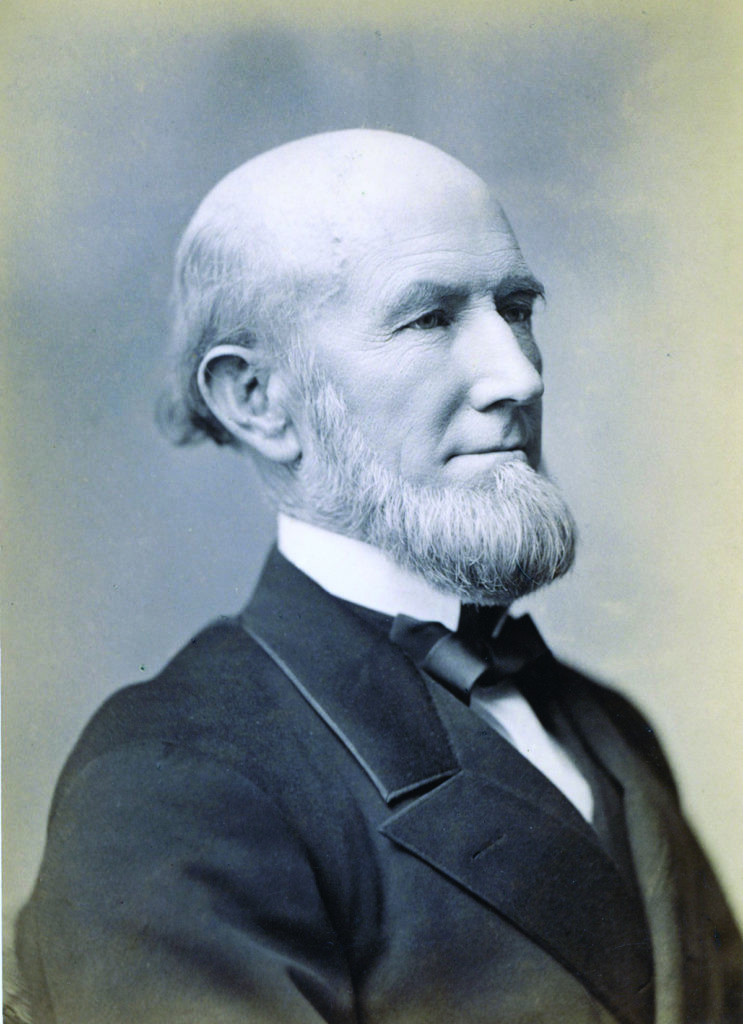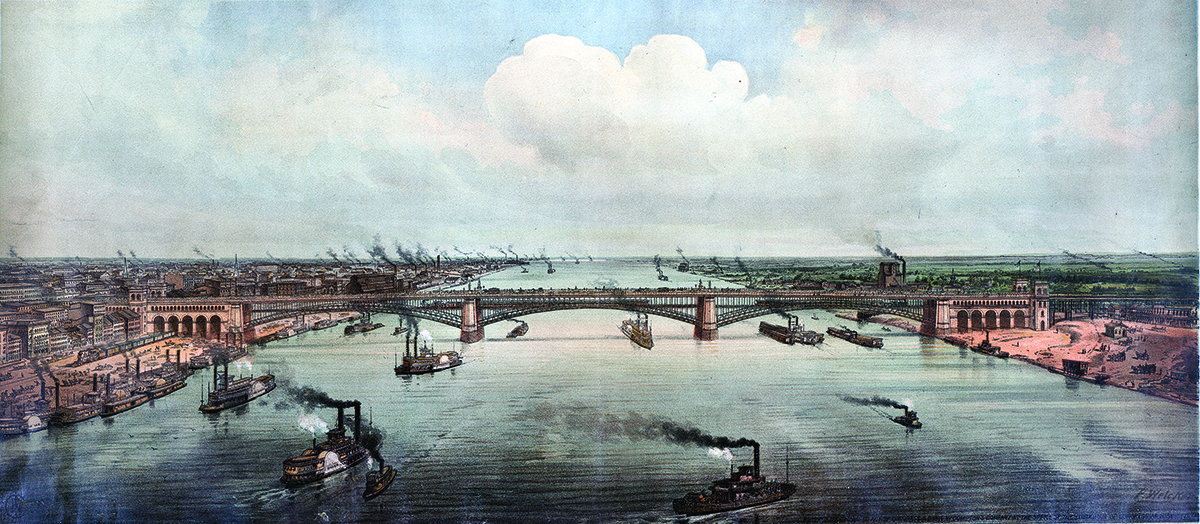As westward migration through St. Louis resumed in earnest after the Civil War, the Mississippi River became an increasingly vexatious impediment to the transport of people, wagons, animals and supplies to the expanding settlements beyond. The manpower required to unload a train on the east bank, transfer cargo to a ferryboat for the crossing and then load the cargo onto a westbound train was time consuming and expensive. Furthermore, the river was impassable when the water was low or frozen, sometimes delaying the transport of supplies for weeks.
Since 1839 various entities had floated the idea of spanning the river with a bridge at St. Louis. That discussion intensified when the Ohio & Mississippi Railroad (later absorbed by the Baltimore & Ohio Railroad) reached East St. Louis in 1857 and tracks fanned out from both banks of the river. Then the Civil War intervened. The idea resurfaced in its wake, but planners faced several obstacles. Riverboatmen were vociferous in their concern a bridge would impede safe passage on the Mississippi, not to mention dilute the dependence of commerce on their steamboats. Meanwhile, Chicago interests were lobbying for railroads to branch north through their city, required easements on the Illinois side of the river appeared prohibitive, and proposals for federal funding failed.

James Buchanan Eads ( Missouri Historical Society)
The practical challenges of constructing a bridge across “Old Man River” particularly intrigued self-taught civil engineer James Buchanan Eads. Born in Lawrenceburg, Ind., on May 23, 1820, and named for his mother’s cousin James Buchanan, the future U.S. president, Eads grew up in St. Louis and had spent his life on the river. Before the war he had invented salvage boats with which to recover cargo from sunken steamboats, and during the war he’d designed a class of ironclad riverboats for the Union.
In 1867, under the auspices of the newly formed Illinois & St. Louis Bridge Co., Eads applied his book knowledge and experience to draw up plans. His proposal called for a bridge with three graceful spans, each supported by four ribbed arches more than 500 feet long—twice the length of any complete bridge yet constructed. Furthermore, he proposed the first use of alloy steel in a major construction project and insisted on sinking the bridge foundations into bedrock. It would also be among the first large spans built using the cantilever principle. That construction approach extends the deck of a bridge horizontally over the river while supported at only one end, allowing river traffic to pass beneath even as the bridge was being built.
In 1868 Eads presented company directors with a detailed report intended to quell any skepticism. In it he delved into existing theories of stress and strain, materials and building methods, explaining in depth the innovative concepts in his proposal. The report met with widespread approval from engineers and scientific journals worldwide, and Eads earned the necessary approval from Congress to begin work.
At the height of the project two dozen boats and some 1,500 men were employed to build the bridge. Eads hit his first benchmark in early February 1870 when the first caisson reached bedrock some 95 feet underwater, an accomplishment signaled with cannon fire and steamboat whistles. After seven years of construction the 6,442-foot landmark span was dedicated on July 4, 1874, the 98th anniversary of American Independence. The St. Louis Post-Dispatch trumpeted the ceremony in banner headlines:
Fifteen Miles of Marching Men, Prancing Horses and Decorated Wagons Have Delighted Two Hundred Thousand Spectators
The bridge, the paper gushed, had been “christened the scientific feat of the country…baptized with water from the four quarters of the republic.” The editors slavishly lavished praise on readers, proclaiming, “The genius and money of [St. Louis’] citizens have built a bridge the like of which the world of capital and science never before dreamed of.” Eads’ name is conspicuously absent from the report.
In retrospect, the self-taught engineer was the obvious choice of a man to build the bridge. His love of and respect for the Mississippi was reportedly kindled during an 1833 steamboat passage with his family. While the vessel made its way upriver, the young teen roamed from pilothouse to paddle wheel, enamored with everything he saw. As it arrived in St. Louis, however, the steamboat caught fire and sank, losing it valuable cargo, including the Eads family possessions. James was forced to leave school and earn a living. Six years later, while working as a clerk aboard the steamboat Knickerbocker, Eads was forced to scramble to safety again as a snag ripped open the bow, claiming that unlucky vessel and its cargo of lead.
Recognizing there was money to be made salvaging lost cargo from such sunken vessels, Eads began mulling ways to do it. By the tender age of 22, with the help of investors, he had designed and built salvage boats and specialized diving equipment he personally used to recover cargo from the fast-flowing river, a risky endeavor that brought financial success. In time he developed vessels and equipment with which to raise entire boats from the river bottom.
During the Civil War President Abraham Lincoln enlisted Eads to design a class of ironclad warships for riverine combat. Eads’ seven gunboats proved decisive in several battles along the Mississippi and Tennessee rivers, including the pivotal Vicksburg campaign.
Concurrent to his ambitious project to span the Mississippi, Eads worked on a plan to open the shipping channel at the mouth of the river south of New Orleans. As the broad river emptied into the Gulf of New Mexico, deposited silt continually choked the passage. Eads designed a system of jetties that narrowed the main outlet, enabling the fast-moving current to cut deep enough to grant vessels reliable year-round access to the river. That project had a monumental positive impact on trade in New Orleans with benefits realized to this day. In gratitude Louisiana authorities named the spit of land at the southernmost extent of the river Port Eads, today marked by a lighthouse and little else.
One idea Eads had that never materialized was an alternative to the hazardous passage of ships around the tip of South America at Cape Horn. His innovative proposal was to transport ships by railway across Mexico’s 120-mile-wide Isthmus of Tehuantepec. The plans called for sliding a 350-foot-long flatbed car—with adjusting rams that formed a cradle to accommodate any hull—beneath a waiting ship in a 450-foot-long dry dock. Once the vessel was secured to the flatbed, powerful locomotives on three parallel sets of tracks would pull the ship onto dry land and across the isthmus. Through the mid-1880s Eads pressed both Congress and the Mexican government for approval to no avail. (The 1914 opening of the Panama Canal finally addressed the problem.) But the inventor remained undeterred. By the time of his death on March 8, 1887, Eads had filed more than 50 patents.
In 1949, after 75 years of service, engineers used modern electromagnetic strain gauges to test the strength of the Eads Bridge. They determined that its designer’s estimated allowable load of 3,000 pounds per foot could be raised to 5,000 pounds per foot, and the graceful span over the Mississippi has remained in daily use ever since. Present-day St. Louis may be known as the “Gateway to the West,” but it was Eads who built a lasting bridge to the West.






